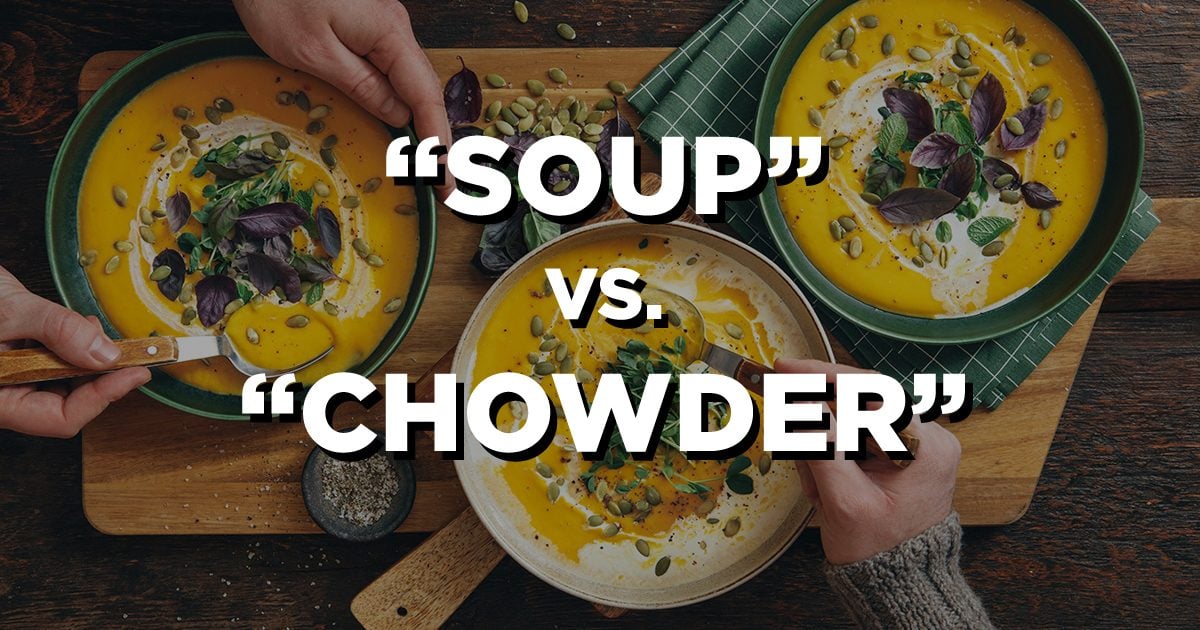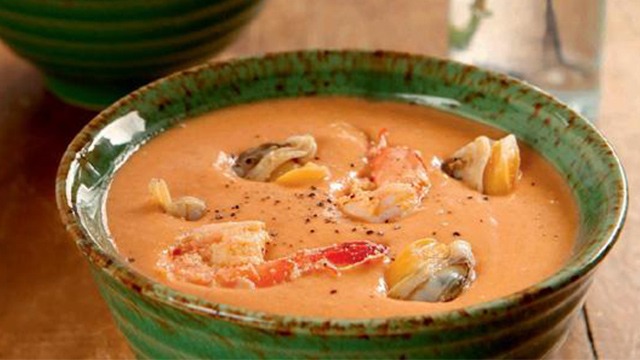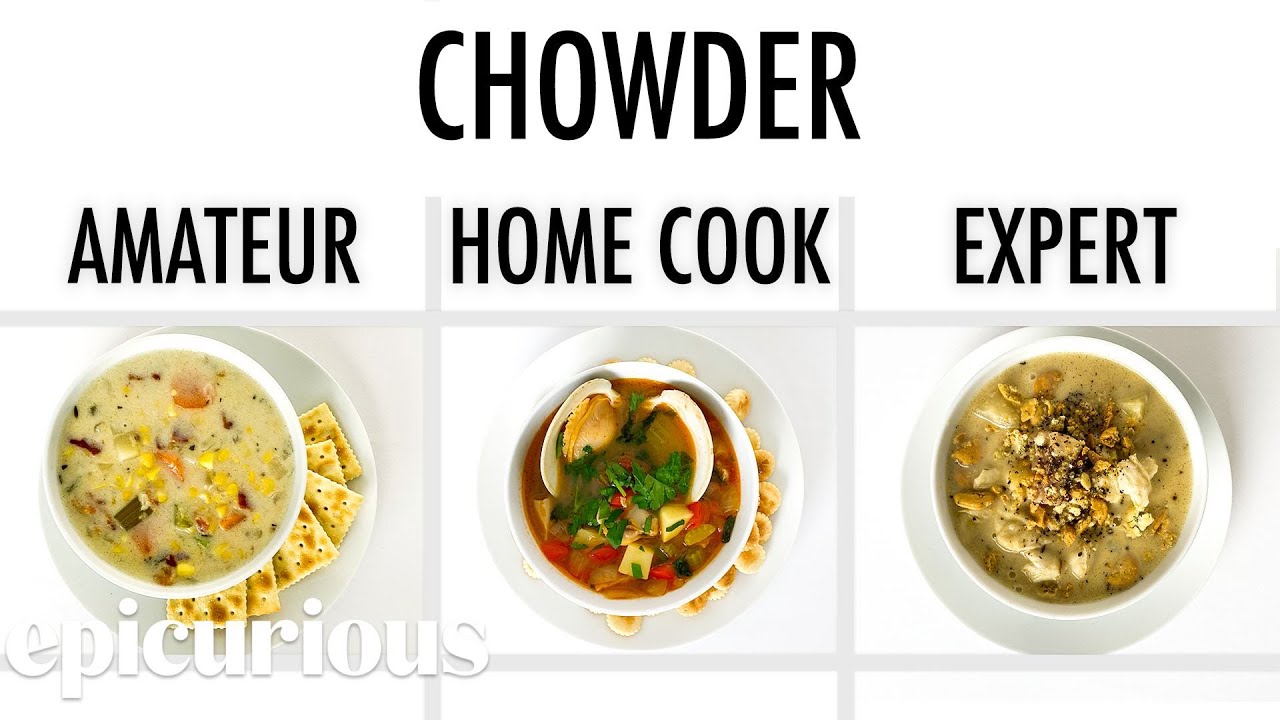Introduction

Soup, chowder, and bisque are all popular dishes that warm our souls and delight our taste buds. While they may all fall under the category of “soup,” each has its own distinct characteristics and origins. In this blog post, we will explore the differences between chowder, soup, and bisque, decoding the unique qualities that set them apart. By understanding the definitions, ingredients, and preparation methods of each, we can appreciate the flavors and textures they offer. So, get ready to dive into the world of soup styles as we unravel the mystery of chowder, soup, and bisque.
Background On Different Soup Styles
Soups have been enjoyed by cultures around the world for centuries, with variations and styles specific to each region. The origins of soup can be traced back to ancient times when heated liquids were used to cook food. Over time, different ingredients and cooking techniques were incorporated, giving rise to a wide range of soup styles. From hearty chowders in New England to delicate bisques in French cuisine, each soup style has its own unique history and flavor profile. Exploring the background of these soup styles allows us to appreciate the culinary traditions and diversity they represent.
Purpose Of The Blog Post
The purpose of this blog post is to provide readers with a comprehensive understanding of the different soup styles, specifically chowder, soup, and bisque. It aims to decode the characteristics, origins, and key differences between these soup styles, allowing readers to appreciate and differentiate them. Through exploring the background, definitions, ingredients, and preparation methods of each soup style, readers will gain a clearer understanding of the unique flavors and culinary traditions associated with chowder, soup, and bisque. This blog post aims to enhance readers’ knowledge and appreciation of these diverse soup styles.
Understanding Chowder

Chowder is a hearty and creamy soup that originated from early American settlers and is often associated with New England cuisine. It is typically made with a combination of seafood, such as clams, fish, or shrimp, along with potatoes, onions, and bacon. The distinguishing characteristic of chowder is its thick and creamy consistency, achieved by incorporating milk, cream, or a roux-based broth. Chowder can be flavored with herbs and spices, such as thyme or bay leaves, and is commonly served with oyster crackers or crusty bread. It is a comforting and satisfying soup that is perfect for chilly days.
Definition And Origins Of Chowder
Chowder is a type of soup that is known for its thick and creamy consistency. It originated from early American settlers and is particularly associated with New England cuisine. The term “chowder” comes from the French word “chaudière,” which refers to a large cooking pot. Chowder was traditionally made by fishermen using ingredients they had on hand, such as fish, clams, or other seafood, along with potatoes, onions, and bacon. Over time, chowder has evolved and now includes various regional variations using different types of ingredients. It has become a beloved comfort food, perfect for warming up on chilly days.
Characteristics And Ingredients Of Chowder
Chowder is known for its rich, thick, and creamy consistency, which sets it apart from other soup styles. It is typically made with a base of potatoes, onions, and bacon, providing a hearty and satisfying flavor. The addition of seafood, such as clams, fish, or shrimp, gives chowder its distinct taste. It often includes other ingredients like corn, celery, or herbs, depending on the regional variation. Chowder is a comforting and filling dish, perfect for warming up on chilly days. Its creamy texture and combination of flavors make it a beloved favorite among soup enthusiasts.
Exploring Soup

Soup is a versatile and widely beloved dish that comes in countless variations. Defined as a mixture of vegetables, legumes, meats, or seafood cooked in a liquid broth, soups can be enjoyed as a light starter or a hearty main course. From classic favorites like chicken noodle soup to exotic creations like Thai coconut curry soup, there is a soup for every taste and occasion. Whether you prefer a clear soup as a base for other dishes or a creamy, comforting puree, soups offer endless possibilities for delicious flavors and nourishing meals. So grab a spoon and start exploring the world of soup!
Definition And Variations Of Soup
Soup is a versatile culinary creation recognized worldwide. It is defined as a mixture of vegetables, legumes, meats, or seafood cooked in a liquid broth. Soups come in a range of variations, allowing for endless experimentation and customization. Some popular types of soup include clear soups like consommé, which is made by clarifying a rich broth, and cream soups like tomato bisque, which are created by blending ingredients with a creamy base. Additionally, there are regional and cultural variations of soup, such as the spicy and flavorful tom yum soup from Thailand or the comforting and hearty minestrone from Italy. Soups can be enjoyed as a light appetizer or a hearty main course, making them a versatile and satisfying meal option.
Differences Between Soup And Other Soup Styles
Soup is a broad category that encompasses a wide variety of different styles and variations. However, when comparing soup to other soup styles like chowder and bisque, there are some key differences to consider:
- Consistency: Soups can range from clear and brothy to thick and creamy, while chowder and bisque tend to have a thicker and heartier consistency.
- Ingredients: While soups can include a wide range of ingredients, chowder usually includes chunks or pieces of meat or seafood, and bisque is typically made with shellfish like lobster or crab.
- Cooking Method: Soups are often simmered for a shorter period of time, while chowder and bisque are typically cooked for a longer time to develop a richer flavor.
- Base: Soups can be made with a variety of bases, such as vegetable or chicken broth, while chowder is usually made with a creamy base like milk or cream, and bisque is typically made with a seafood stock or broth.
In summary, while soup is a more general term that encompasses many different styles, chowder and bisque have their own distinct characteristics in terms of consistency, ingredients, cooking method, and base.
Decoding Bisque

Decoding Bisque:
Bisque is a luxurious and creamy soup that has a rich history and distinct characteristics. Originating in France, bisque is traditionally made with shellfish like lobster, crab, or shrimp. What sets bisque apart from other soups is its smooth and velvety texture, achieved by pureeing the ingredients. It typically includes a base of seafood stock or broth, and is often enriched with cream and wine for added depth of flavor. The result is a decadent and indulgent soup that is full of savory goodness. So if you’re looking to spoil yourself with a sophisticated and elegant soup, bisque is the way to go.
Definition And History Of Bisque
Bisque is a luxurious and creamy soup that has a rich history and distinct characteristics. Originating in France, bisque is traditionally made with shellfish like lobster, crab, or shrimp. What sets bisque apart from other soups is its smooth and velvety texture, achieved by pureeing the ingredients. It typically includes a base of seafood stock or broth, and is often enriched with cream and wine for added depth of flavor. The result is a decadent and indulgent soup that is full of savory goodness. So if you’re looking to spoil yourself with a sophisticated and elegant soup, bisque is the way to go.
Key Ingredients And Preparation Method Of Bisque
Bisque is traditionally made with shellfish such as lobster, crab, or shrimp, which gives it its distinct flavor. The preparation method for bisque involves several steps to achieve its smooth and velvety texture. First, the shellfish is cooked and the meat is extracted. The shells and potentially some of the meat are then simmered to create a flavorful stock. The stock is strained and blended with aromatics like onions, carrots, and herbs. Cream is added for richness, and the mixture is pureed until smooth. Additional seasonings, such as wine, shallots, and spices, may also be incorporated to enhance the flavor.
Comparing Chowder, Soup, And Bisque

Chowder, soup, and bisque are all delicious soup styles, but they each have their unique characteristics.
Chowder is known for its thick and creamy consistency, often made with ingredients like potatoes, onions, and seafood or vegetables. It has a hearty texture and is typically served as a main course.
Soup, on the other hand, is a more general term that encompasses a wide variety of liquid-based dishes. It can be thin or thick, hot or cold, and made with various ingredients such as meat, vegetables, or grains. Soups can be enjoyed as both appetizers and main courses.
Bisque, unlike chowder and soup, is specifically made with shellfish such as lobster, crab, or shrimp. It is known for its smooth and velvety texture, achieved by simmering the shells and blending the mixture with cream. Bisque is often served as a luxurious starter.
In summary, while all three soup styles offer delicious flavors, chowder is rich and hearty, soup is versatile and variable, and bisque is smooth and indulgent.
Key Differences Between Chowder, Soup, And Bisque
Chowder, soup, and bisque each have distinct characteristics that set them apart from one another. The main differences lie in their consistency, ingredients, and flavors.
- Chowder is known for its thick and creamy texture, often made with ingredients like potatoes, onions, and seafood or vegetables.
- Soup is a more general term that encompasses a wide variety of liquid-based dishes, ranging from thin and brothy to thick and chunky, and can be made with various ingredients such as meat, vegetables, or grains.
- Bisque, on the other hand, is specifically made with shellfish such as lobster, crab, or shrimp, and is known for its smooth and velvety texture achieved by simmering the shells and blending the mixture with cream.
These differences in texture, ingredients, and flavors make each soup style unique and enjoyable in its own way.
Common Misconceptions And Misconceptions Clarified
It is important to address some common misconceptions about chowder, soup, and bisque to provide a clearer understanding of these soup styles. One common misconception is that all creamy soups are bisques, when in fact, bisques specifically refer to soups made with shellfish. Another misconception is that chowder and soup are interchangeable terms, but they have distinct characteristics and ingredients. Additionally, many people believe that soups must be thin and brothy, when in reality, they can range from thin to thick and chunky. Understanding these differences helps to appreciate the unique qualities of each soup style.
Conclusion

In conclusion, understanding the distinctions between chowder, soup, and bisque can enhance our appreciation for the unique qualities of each soup style. Chowder is known for its chunky texture and typically includes seafood or vegetables. Soup, on the other hand, can vary in consistency and ingredients, ranging from brothy to thick and chunky. Bisque is a special type of soup made with shellfish. By debunking common misconceptions and clarifying the true definitions of these soup styles, we can explore and savor the rich and diverse world of soups.
Summary Of The Main Points Discussed
Throughout this blog post, we explored the distinctions between chowder, soup, and bisque. We learned that chowder is a chunky soup, typically made with seafood or vegetables, while soup can vary in consistency and ingredients. Bisque, on the other hand, is a special type of soup made with shellfish. We debunked common misconceptions and clarified the true definitions of these soup styles. By understanding their unique characteristics and origins, we can now appreciate the rich and diverse world of soups. So, the next time you’re craving a warm and comforting bowl of soup, remember the differences between chowder, soup, and bisque.
Final Thoughts And Recommendations
In conclusion, understanding the distinctions between chowder, soup, and bisque allows us to appreciate the diverse world of soups. Chowder stands out with its chunky texture and seafood or vegetable base, while soup offers a range of consistencies and ingredients. Bisque, a special type of soup made with shellfish, adds a unique flavor profile. It’s important to remember that these soup styles have their own origins, characteristics, and preparation methods. So, the next time you’re craving a comforting bowl of soup, choose the style that best suits your preferences. Enjoy exploring the delicious world of chowder, soup, and bisque!
Frequently Asked Questions: Chowder vs Soup vs Bisque
Q: What is the main difference between chowder, soup, and bisque?
A: The main differences lie in their thickness, ingredients, and preparation methods.
Q: How would you describe chowder?
A: Chowder is a rich, creamy, and hearty soup that typically contains chunks of vegetables, seafood, or meat. It is thickened with flour or potatoes and often prepared with milk or cream.
Q: What are some popular types of chowder?
A: Some popular types of chowder include New England clam chowder, corn chowder, fish chowder, and seafood chowder.
Q: Is all chowder made with seafood?
A: No, while seafood chowders are the most well-known, chowders can also be made with ingredients such as vegetables, chicken, or bacon.
Q: How would you define soup?
A: Soup is a liquid-based dish made by combining various ingredients like vegetables, meat, legumes, or grains. It can be thin or thick and can be served hot or cold.
Q: What are some common types of soups?
A: Common types of soup include vegetable soup, chicken noodle soup, tomato soup, minestrone, and French onion soup.
Q: Can soups be made with broth or stock only?
A: Yes, some soups can be made with broth or stock as the base, while others may have a thicker consistency by adding ingredients like cream or pureeing some of the ingredients.
Q: What is bisque?
A: Bisque is a smooth and rich soup that is typically made with shellfish, especially lobsters or crabs. It is traditionally thickened with rice or stale bread and finished off with cream.
Q: Are bisques always made with shellfish?
A: While seafood bisques are the most common, bisques can also be made with vegetables or poultry, although they may have a different name, such as tomato bisque or mushroom bisque.
Q: Can you describe the texture and taste of bisque?
A: Bisque has a smooth and velvety texture, achieved through pureeing or straining the ingredients. It has a rich and luxurious flavor, often enhanced by the addition of cream or butter.
Q: Can chowder, soup, and bisque be served as a main course?
A: Yes, they can be served as a main course, especially if they contain substantial amounts of proteins like seafood, meat, or legumes. Some recipes also include added carbohydrates, such as potatoes, rice, or noodles, making them more filling.
Table comparing Chowder, Soup, and Bisque:
| Chowder | Soup | Bisque | |
|---|---|---|---|
| Texture | Thick and chunky | Varies (from thin to thick) | Smooth and velvety |
| Base | Milk or cream-based | Broth, stock, or tomato-based | Cream-based (with shellfish) |
| Ingredients | Chunks of vegetables, seafood, or meat | Variety of ingredients | Primarily shellfish |
| Thickness | Thickened with flour or potatoes | Can be thin or thick | Thickened with rice or bread |
| Preparation | Simmering and typically longer cooking time | Quick cooking or slow simmering | Pureeing or straining |
| Examples | New England clam chowder, corn chowder, seafood chowder | Chicken noodle soup, vegetable soup, minestrone | Lobster bisque, tomato bisque, mushroom bisque |
Remember, the specific characteristics of chowder, soup, and bisque can vary depending on region and individual recipes. Enjoy exploring the diverse and delicious world of these comforting dishes!

Everyone has had a recipe that looked great on paper but ended up burning once you got into the kitchen. Obviously, a recipe isn’t just about what ingredients go into it. Knowing how you prepare a dish has a strong impact on how it finally tastes.